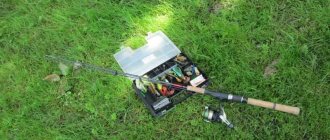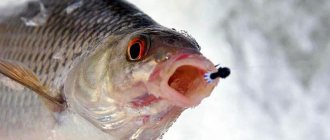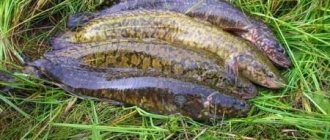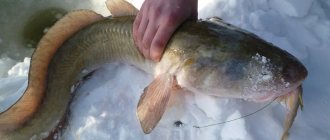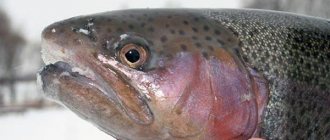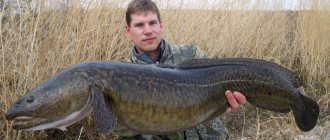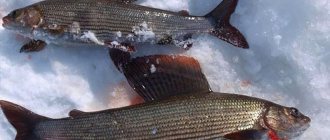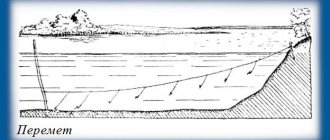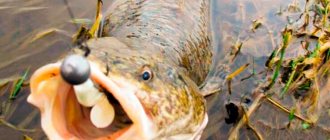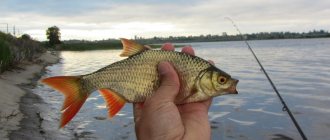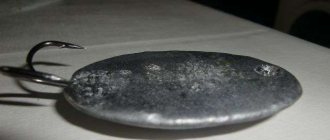What is a postavushka, its differences from a zherlitsa
Postavushka is a passive type of gear that is used for ice fishing. It consists of a reel or a thick stick, a fishing line with a sinker, and hooks. The installation principle is quite simple:
- The support element is attached to the ice.
- The fishing line with the equipment is lowered into the pond.
- The device is lightly covered with snow.
You can install the stand and go about your business or even go home. Return in the morning or a few days later, take out the catch, attach new bait and lower it into the reservoir again.
Rice. 1. The principle of fishing with a stand.
The zherlitsa is essentially the same supply, but more modified. It is equipped with a bite alarm. Its role can be a flag or a bell. In the second case, the fisherman remains near the gear in order to hear the signal in a timely manner and catch the predator. If the checkbox is checked, then you can leave, returning to the reservoir; the raised bite alarm will make it clear where the fish are. You don’t have to pull out the equipment everywhere, if you just check the condition of the bait.
Rice. 2. What does a burbot bait look like?
The supply has the following advantages:
- does not freeze to the hole;
- invisible to people;
- It has a compact size, you can easily carry it with you even in quantities of several pieces;
- easy to make with your own hands from scrap materials;
- can be left unattended.
Expert opinion
Valery Andreevich Sizov
Professional fisherman with 35 years of experience
Note! If you leave the stand on the pond, it must be camouflaged. This is necessary so that dishonest people do not stumble upon it and appropriate the catch for themselves.
Looking for burbot in winter
In order to catch burbot in winter using bait (as well as other gear), it is important to understand one feature of this predator. This fish lives sedentary in the same parking areas, making short walks every night in search of food along permanent paths. Therefore, winter fishing for burbot using baitfish will be effective only if you know specific habitats, trails, or find them on a new unfamiliar body of water. It's good if this place is known. If the reservoir is unfamiliar, then it is necessary to use the tactics of searching for this fish, which is described below. The search may take a long time, but if you find a parking spot, you can count on fishing at that point for years to come. There are not so many suitable places for burbot to stay on reservoirs; the entire population will be dispersed among them. For information on where to look for burbot on a river or lake, read the article:
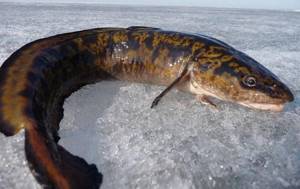
In regions of Siberia and on large northern rivers, where the semi-anadromous population is widespread, the main thing is also to find a path along which the fish rises in winter during the spawning period. The path is often very narrow, literally a meter wide. But during the winter in this particular place it will be possible to catch a large number of fish. Burbot is not scattered throughout the water area; it gathers in strictly defined places. The main difficulty in fishing for it is finding it. The bait for burbot in winter (and other gear too) is not expensive or difficult to manufacture. Of course, there are certain features, more on them later.
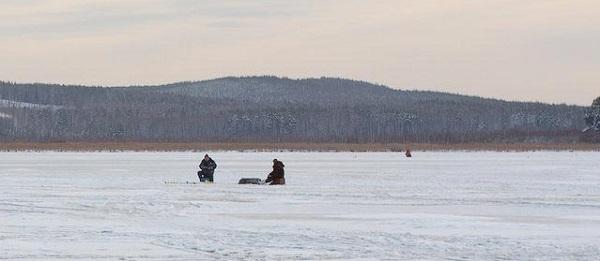
When is delivery most effective?
You need to go for burbot when the temperature drops below +13 degrees. In the warm season, the predator shows low activity. Of course, it can be caught at great depths, but the chances are slim. Fish swim out to hunt at night, so it makes no sense to go before 7 pm.
You can leave this gear and leave, or at the same time use sport fishing for predators. For example, sit with a winter fishing rod in one of the holes, periodically checking the tackle for a catch. Unlike a zherlitsa, the postavushka will not distract attention with flag shots.
Tactics for catching burbot using girders
Catching burbot on a girder in winter is quite an active activity. You can go out for burbot with girders, and use only them. You can catch only by knocking, using special tackle, a knocker, as well as burbot spinners or cone jigs.
Bottom tackle for catching burbot in winter with live bait is similar to a girder, it’s just that such a fishing rod is not left unattended, but is constantly under control. All this is good if the fisherman already knows the parking place or the path of movement of the fish. If it is the fisherman’s first time at the reservoir, and only knows that there is definitely burbot somewhere here, then it will be more effective to use a combined search method, using both girders and fishing rods. Let's take a closer look at how to catch burbot using girders in winter if the location of this fish is unknown in advance.
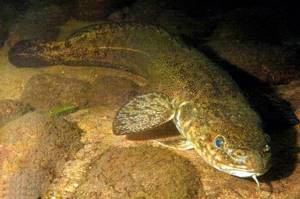
It all depends on the time you have allocated for fishing and personal preference. As you know, for maximum results for burbot it is necessary to organize night fishing. This fish is active at night, especially in the first and second half of this time of day. At midnight there is a decrease in activity. In any case, you need to stay overnight. Or, at a minimum, install the girders in the evening in already explored places (for example, at the points of capture by snitching), and check them the next morning. This is realized by several fishing rods and one fishing rod. You can, for example, place baits in promising places, and while they are guarding the predator, actively search for and fish other points. By nightfall, you need to move the gear to where the bites were. At night, you can continue fishing with a fishing rod in a tent at a permanent place of work, periodically checking the fishing rods.
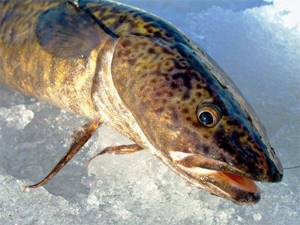
Choosing a place to install the supply
This gear can be installed in absolutely any expected burbot habitat, for example:
- in holes in the riverbed;
- in places with snags at the bottom;
- in long ditches and ravines;
- on steep banks with sharp sheer edges;
- in places where there are bridge supports, submerged slabs, large stones, etc.;
- near uneven bends of the coastal zone;
- near sand spits in zones of transition to depth.
Burbot prefers a rocky or sandy bottom. Where it is covered with vegetation or silt, this predator cannot be found.
Expert opinion
Valery Andreevich Sizov
Professional fisherman with 35 years of experience
Helpful information! The predator uses one path to feed from year to year. It is called the burbot trail. If you manage to find it, you can go fishing there all the time. If the predator sites are unknown, you will have to search for them through trial and error. Place stands along the entire coast, exploring interesting places with the help of sport fishing gear.
How to make tackle yourself
How to make a fishing stand with your own hands:
- Prepare a stick in the form of a slingshot. The length of the forked part should be 15-20 cm, and the handles 10-15 cm.
- Having retreated a few centimeters from the bottom of the solid stick, make a through hole.
- Make a groove in one of the bifurcated parts.
- Wind the main line around it (with a cross-section of 0.4-0.5 mm and a length of 20-50 m) so that each turn does not overlap the previous one.
- Attach a 50 cm fluorocarbon or steel leader to the free tip of the rig using any reliable knot or swivel.
- Install a single, double or triple hook at its end.
- Attach a load of 50-100 g to an additional branch from the main line, depending on the strength of the current.
- Pass a rope or cord through the hole located in the handle. Make a loop that will secure the tackle on the ice.
Installation of such a simple installation takes 5 minutes. On a pond, you need to unwind the required amount of fishing line (so that it reaches the bottom). Fix the remainder in the slot. Lower the slingshot stick into the pond, securing it with a loop to a stick placed on the ice or ground.
Rice. 3. Slingshot stand.
There is also a simple way to make a supply yourself (equipment with the same characteristics as in the previous version):
- Take a reel approximately 35 cm long and 5 cm wide. If you don’t have one, you can use a board or sleeve with similar dimensions and make a wedge-shaped recess on each side.
- Wind 20-50 m of fishing line into these cuts.
- Attach a sinker with a carabiner to the tip of the rig.
- Attach a leash with a hook to it.
Rice. 4. What should happen.
This gear is intended for winter fishing for burbot . Installation is very simple: make a hole, immerse the equipment in water until it reaches the bottom. A reel or board is placed across the hole in the ice. Thanks to this, the hole will not freeze and will not drag on.
Supplies for burbot - production and fishing features
Burbot, the only freshwater representative of cod , is a rare species of omnivorous predator. Hunts for small fish, chases nimble ruffs, collects crayfish and insects. Prefers fresh prey, but will not disdain fish or frogs that are beginning to decompose. The liver helps fish cope with poisoning that can be caused by carrion. The weight of this “filter” can reach 9% of the total body weight of the fish.
People value burbot for this “gift of nature”, useful for its high content of fish oil and vitamins. The fish prefers cold running water and hunts at night. In winter, activity increases and the predator requires a lot of food.
The fishermen came up with a supply based on the hunger and greed of winter burbot. Making a burbot stand with your own hands will take a few minutes if you have a fishing line, leash, hook and sinker on hand. When deciding to use this non-sports fishing equipment, you must take into account that the surrounding hunters will not flock to the same bait.
The effectiveness of the delivery is relative , and you can count on a good catch by placing several dozen shells throughout the reservoir. Therefore, prepare a piece of plastic water pipe for the base of the tackle. A length of 20 cm will be optimal.
At one end, drill two through holes through which pass a thick fishing line or nylon cord and tie a loop. Then you will use it to attach the stand over the hole so that the fish does not take the tackle into the water.
To hold a large burbot, you will need a strong fishing line, especially for breaking. A monofilament of 0.5-0.6 mm is guaranteed to hold a fish of 3-4 kg, and a leash of 0.3 mm will not allow the burbot to bite off the hook. A leash is also needed to quickly replace a worn-out hook.
If a burbot swallows bait , the hook along with it will end up in the fish's stomach. Getting it out will be a hassle; it’s easier to just replace it. Have a good supply of ice fishing leads.
Carefully wind 6-7 meters of fishing line around the tube and secure it in the slot at the other end. The line should be easy to release and quickly go into the water, but fixation is necessary so that the tackle does not get tangled.
This article will show you homemade fish traps and tell you how to use them.
In this article we will talk about the features of catching perch with a reelless reel in winter.
The proposal to use a long sinker on the line saved fishermen from problems with fishing line getting tangled. The sinker can be made from a lead rod. There are models of weights in the form of a metal rod with loops at the ends. There should be at least 0.5 m between the hook and the weight so that the bait has some freedom of movement.
You can make a locking loop on the fishing line, which will not allow the load, when installed on the hole, to reach the leash with the hook. A 50-100 gram sinker will hold the bait well at the bottom even in strong currents. A heavy sinker - “Cheburashka” can be another load option.
A leash made from fishing line is attached with a quick-release loop to one eye, a long fishing line to the second, and there will be a stable distance between the bait and the sinker.
The problem with the “sail” effect of the fishing line that occurs in the current, which is carried away by the current and freezes to the edges of the hole, is solved with the help of an additional sinker. Attach it to a fishing line 1-1.5 meters from the hole , and it will hold the fishing line in a vertical position.
The point of the hook should be very sharp and the shank should be long. The longer the better. Hooks No. 10 (no less), single and double, will require special preparation. Sharpen the points and move them slightly away from the vertical using pliers. The grip will increase and the hook will not be able to reverse. The leash is attached to the fishing line using the usual “loop to loop” technique.
The best bait for a predator is live prey. Any small fish is suitable for the role of live bait , but the ruff will attract burbot longer than others, and its “ruffy” back can help the hooks hold large fish. It’s not difficult to catch a ruffe; a winter fishing rod with a drop jig and a piece of bloodworm will provide live bait for more than one fish.
A small fish trap made from a plastic bottle and bait will consistently attract sprat, ruffe and minnows.
Interested in goat fishing in winter? Our article will tell you and show you more about this.
And here you will see the basic techniques for catching fish while rolling in winter and summer.
The long forend of the hooks allows the baitfish to remain active longer; the ruff can move for several days until the burbot comes “for lunch.” You need to attach live bait in such a way as to damage it as little as possible. The best way is behind the lips so that the points come out near the eyes.
Burbot hunts at night; its hunting grounds are bottom waters. In the running cold water of northern rivers you can see and catch surprisingly large specimens. +10 is my favorite temperature.
Cold water, depleted of oxygen, forces potential prey to go into “winter quarters”, into hibernation, so hungry burbot in winter will go to the bait for both active live bait and inanimate bait. Pieces of fish or meat may attract a predator, although he will accept the bait with less enthusiasm.
Drill holes at a distance of 4-5 meters from each other , with an expectation of a depth of 3-4 meters. Burbot bites in the current, but without much drift. Its hunting grounds are shallows, flowing places with a rocky or sandy bottom.
But during the daytime, the predator hides in secluded places: under snags, in tangles of sunken branches, in holes with running water. You can throw bait there with the expectation that it will be the first thing the burbot sees when going out on the “trail” at night.
The success of baitfish in catching fish is not the same, even with live bait or tasty meat bait. The predator is extremely curious and greedy, but for unknown reasons it can ignore the ruff that is “put in its mouth.” Therefore, when making this gear, follow the rule “the more, the better”; stock up on leashes and a variety of bait.
You can experiment with bait. You can try to accustom the burbot to one feeding place by periodically feeding complementary foods in the fall.
You can find supplies on sale , but they are made abroad, in China. Plas does not look very reliable, but the fishing line and three or four leashes included in the kit inspire hope for success. The set costs 80-90 rubles.
Therefore, we can confidently say that the cost of homemade gear will be less. Having filled your hand, you can make several dozen in a day. There are never enough supplies.
This article will help you in choosing a fishing rod.
And here you will learn how to catch bersh in winter.
In this section you will find information about winter fishing.
What can be used as bait
When fishing for burbot, it is best to use live bait as bait. The strongest are ruff and perch. If you use them as bait, the supply may not be checked even for several days. In addition, the ruffe in its natural environment eats burbot eggs, so the predator will attack it well.
However, if fishing takes place in winter, live bait is not easy to get. Alternatively, you can use pieces of meat or freshwater and saltwater fish. Burbot will also go for this bait, but less willingly.
Live bait must be placed with great care. This can be done in two ways:
- hook onto the hook under the upper fin to the back, being careful not to damage the spine, otherwise the bait will quickly die;
- insert a sharp rig through the mouth and bring it out under the gills (in this case, the leash only catches after the bait is attached).
If you plant pieces of meat or fish, take them large enough (5-7 cm) so that they are not eaten instantly.
Fishing with supplies
Where the burbot shows itself by biting, holes are drilled along the shore and perpendicular to it. They can be arranged in two lines in a checkerboard pattern, if you need to carefully fish an edge or slope, or according to some other pattern - it all depends on the shape of the underwater habitat of the burbot.
The huts work productively until the burbot spawning, which begins in mid-January. Then they resume fishing from the end of February, when burbot begins to feed heavily.
Postavushki are primitive tackle. 10–12 meters of fishing line with a diameter of 0.4 mm are wound on a basic reel, at the end of which a leash made of the same fishing line is tied through a swivel. A single hook made of annealed wire should be barbless and easily removed from the burbot. Live bait is baited through the mouth and palate. After hooking the fish, the hook is fixed with a piece of rubber near the sting. A regular hook with a long shank and barb (No. 3–1/0) is swallowed deeply by burbot, so the leash should be attached through a clasp that allows quick detachment of the equipment.
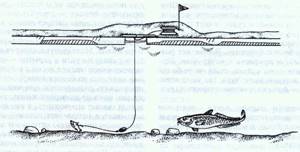
On the main fishing line, I use a wooden sliding ring, with which it is convenient to fix the equipment in the center of the hole. These rings can be bought at Ikea. They come complete with wooden cornices and are inexpensive. I insert a stick into the ring, which I then place across the hole and cover with a high pile of snow to prevent the equipment from freezing into the ice. I hang the reel on another stick stuck nearby in the snow. There should be no reserve of fishing line to limit the burbot’s movement.
The range of attachments is quite wide. If in reservoirs burbot prefers almost exclusively live bait, then ruff, gudgeon, chicken guts, and a large bunch of worms are suitable for river predators.
Useful tips
Tips from experienced fishermen will help simplify burbot fishing:
- If you plan not just to set up the tent and leave, but to stay by the pond all night, you need to take a tent with you so that you can shelter from bad weather. The predator loves rain, snow, and strong winds, so it is better to go fishing in bad weather.
- You should definitely have a flashlight with you, or better yet several, because at night it can be difficult to see anything. In addition, the predator prefers days when there is no moon in the sky to illuminate the shore.
- It is advisable to build a fire near the fishing spot. Its light attracts burbot in the same way as the radiation from lanterns.
- It is sometimes difficult to get to the shore where fishing will take place by car. If there is no snow yet, it is recommended to take a cart with you so as not to carry gear on yourself. In winter, you can use a sled.
- It will be cold at the reservoir at night, you need to dress warmly, take a change of clothes with you just in case, hot tea and food.
- You must be extremely careful when going out on the ice. First make sure of its strength, especially during a prolonged thaw.
Summing up, we can conclude that the bait is one of the most effective tackles for burbot. It is used mainly in winter, when the predator is most active. However, application is possible at any other time of the year. In this case, the tackle is tied to a tree or fixed to a stick stuck in the ground.
You can sprinkle the stand with snow to hide it from strangers, remember the place and go home, coming to check it every few days. This gear can also be used by active fishing enthusiasts as an additional fishing method.
What is a burbot snitch, how to make it with your own hands and fishing techniques, read our article.
How to avoid basic mistakes?
Burbot fishing takes place in winter, during the cold season. You shouldn’t rely on catching burbot in December with girders in winter. They will remain empty, especially at the beginning of the month. The end of December and the beginning of January is the period of active spawning of the predator. At this time he refuses any food. You need to catch it in bad weather and in extreme cold. It is difficult to catch him during the day, because he usually leads a nocturnal lifestyle. The predator is especially active from 21:00 to 1:00 am and from 3:00 to 5:00 am.
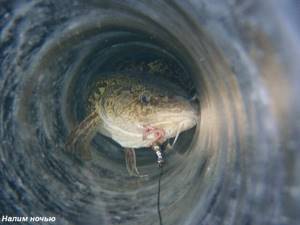
The most catchy holes will be those drilled above the path of movement or above the fish collection area. You should look for these places at differences in depth: next to underwater holes, near gentle shores. It is recommended to place the traps at night at a distance of 5-8 m from the pits upstream of the river. You need to drill a hole approximately 30 cm in diameter. This will make it possible to pull out even large fish.
It is worth tying several leashes to the harness. Live bait will set them in motion, which can attract several specimens of prey.

